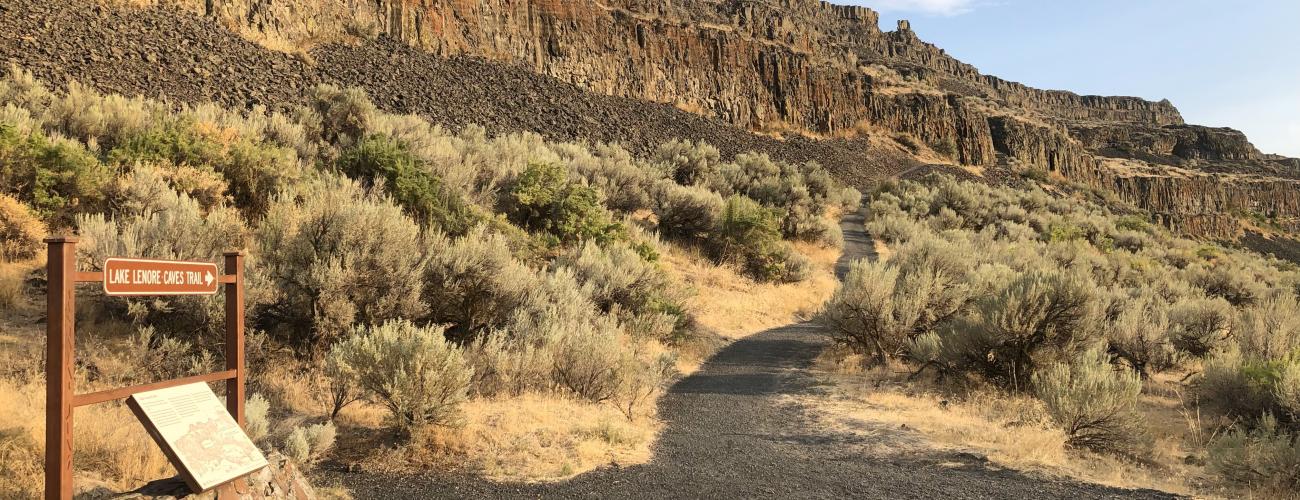Lake Lenore Caves State Park Heritage Site History
Lake Lenore Caves State Park Heritage Site offers visitors a window into the formation of the Grand Coulee and the lives of people who may have spent time here thousands of years ago.
Indigenous Lands
Lake Lenore Caves State Park Heritage Site lies within the traditional territories of Sahaptian and Interior Salish Indigenous people whose present-day descendants include members of Confederated Tribes of the Colville Reservation and the Confederated Tribes and Bands of the Yakama Nation. For millennia, the lands and waters of this area have provided habitat for a diverse community of life that forms the basis of their cultures. Shrub-steppe landscapes of the Grand Coulee provide important root collection areas for biscuitroot (Lomatium canbyi) and bitterroot. Traditionally, the Indigenous people of the region leave winter residences in the spring to travel to various river and plateau areas to collect, hunt and fish on seasonal rounds.
Some local tribes ceded ownership of the area to the US federal government under duress in the Yakima Treaty of Camp Stevens in 1855, keeping rights to harvest resources in their usual and accustomed places. Other tribes and bands such as the Columbia-Moses (Sinkayuse) were subjected to a series of executive orders by US Presidents that established and dissolved reservation areas and ultimately relinquished ownership of their homelands to the US federal government.
Government land surveys were completed in 1882, but none of the lands in today’s Lake Lenore Caves State Park Heritage Site were ever patented into private ownership from the public domain.
J Harlen Bretz’s Outrageous Hypothesis
J Harlen Bretz, a Professor of Geology at the University of Chicago, wondered what forces could have carved the features of the Grand Coulee. For eight summers, Bretz traveled to eastern Washington with his wife, two young kids, the family dog, and a few college students. He became convinced that neither streams nor glacial erosion had sculpted the landscape. In his memoir he recalled, "I could conceive of no geological process of erosion to make this topography except huge, violent rivers of glacial meltwater."
Initially dismissed by many geologists as an “outrageous hypothesis,” Bretz's explanation of the Grand Coulee story was fully vindicated in 1965, when a group of geologists from the International Association for Quaternary Research toured the region and sent the then-83-year-old Bretz a telegram: "We are all now catastrophists."
Geologists now believe that the Lake Lenore Caves (or more accurately, rockshelters, as they do not extend to a depth that light does not enter from outside) were formed during the ice age floods described by Bretz, when churning waters scoured through Grand Coulee after being released from Lake Missoula. The massive lake covered a large swath of today’s western Montana when it was repeatedly impounded and released by advances and retreats of glacial ice. Extremely powerful currents in the floodwaters plucked away at the walls of the coulee, eroding fastest where columns of basalt were dislodged. The Lake Lenore Caves were scoured from just such basalt colonnades.
Grand Coulee Archaeology
State Senator Nat Washington represented Washington’s 13th District, which includes the Grand Coulee, from 1951-1979. With a deep interest in archaeology, especially in the arid lands of Central Washington, he sponsored legislation to protect archaeological resources and facilitate professional study. From 1958 to 1961, professors and students from Washington State University and the University of Washington surveyed the Grand Coulee with funding authorized by the legislature through the Division of Mines and Geology and the Washington State Parks and Recreation Commission (WSPRC). Responsibility for archaeology and historic preservation in Washington was led by the WSPRC for many years before the Office of Archaeology and Historic Preservation (since 2005, the Department of Archaeology and Historic Preservation) was created in 1977.
The research established that Indigenous people utilized Grand Coulee rockshelters during their seasonal rounds, leaving pictograph images, fragments of rope cordage, baskets and mats, and an assortment of chipped rock points. Unfortunately, at the Lake Lenore Caves and many other sites, the professional archaeologists also found that more than a foot of the rockshelter floor had been dug and overturned by illegal artifact seekers, ruining the opportunity to learn from the cultural stratigraphy of the site. Artifacts are now strictly protected by state and federal laws.
Becoming a State Park
With Senator Nat Washington’s advocacy, the Washington Legislature appropriated $30,000 in 1961 for the WSPRC to develop an interpretive site in the Grand Coulee to tell the story of Indigenous use of the rockshelters and protect the site. The Lake Lenore Caves area was selected as an appropriate site to be carefully developed for public access and education. The majority of the funding was used for additional interpretive displays at the nearby Dry Falls Interpretive Center, opened in 1966.
By 1968, the access road, parking area and a rustic trail to the Lake Lenore Caves were open to the public. Title to the land was transferred to the WSPRC on October 26, 1972, under terms of the Recreation and Public Purposes Act of 1926, which authorized the sale of public domain lands to public agencies for park purposes at a cost of $2.50 per acre.
Sharing the histories of Washington’s state parks is an ongoing project. Learn more here.

